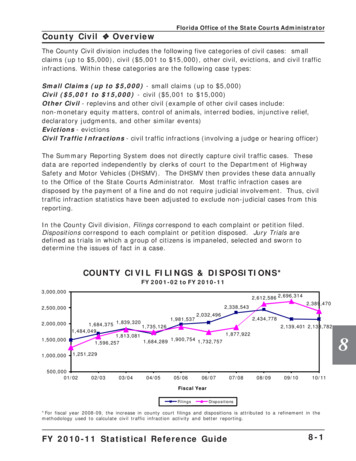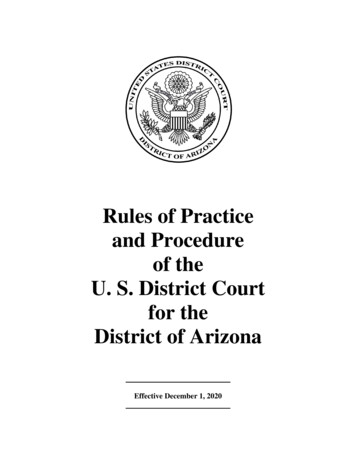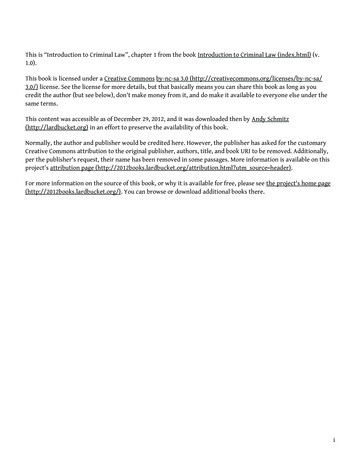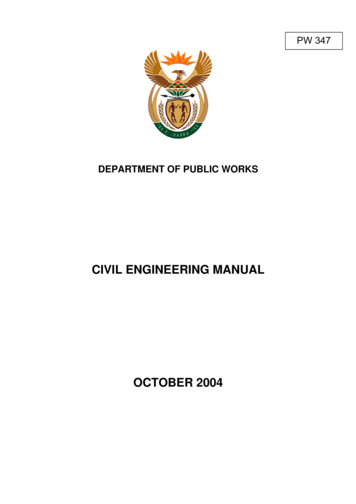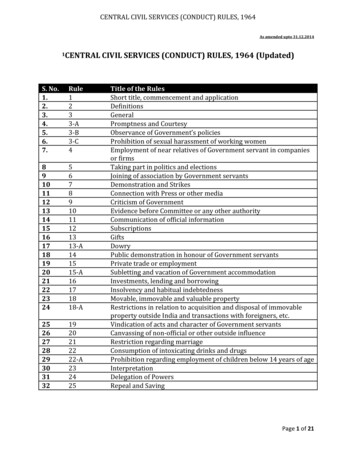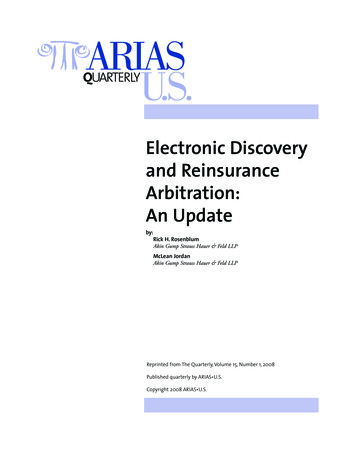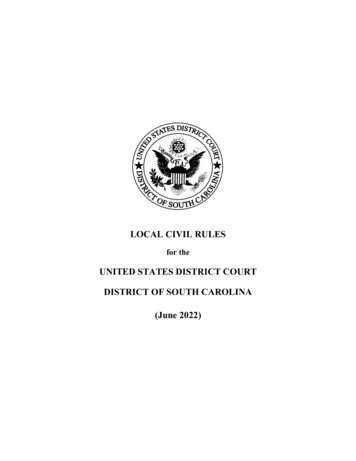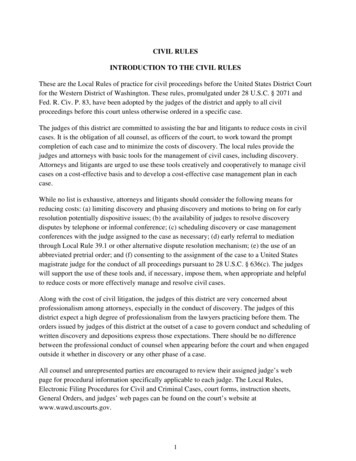
Transcription
CIVIL RULESINTRODUCTION TO THE CIVIL RULESThese are the Local Rules of practice for civil proceedings before the United States District Courtfor the Western District of Washington. These rules, promulgated under 28 U.S.C. § 2071 andFed. R. Civ. P. 83, have been adopted by the judges of the district and apply to all civilproceedings before this court unless otherwise ordered in a specific case.The judges of this district are committed to assisting the bar and litigants to reduce costs in civilcases. It is the obligation of all counsel, as officers of the court, to work toward the promptcompletion of each case and to minimize the costs of discovery. The local rules provide thejudges and attorneys with basic tools for the management of civil cases, including discovery.Attorneys and litigants are urged to use these tools creatively and cooperatively to manage civilcases on a cost-effective basis and to develop a cost-effective case management plan in eachcase.While no list is exhaustive, attorneys and litigants should consider the following means forreducing costs: (a) limiting discovery and phasing discovery and motions to bring on for earlyresolution potentially dispositive issues; (b) the availability of judges to resolve discoverydisputes by telephone or informal conference; (c) scheduling discovery or case managementconferences with the judge assigned to the case as necessary; (d) early referral to mediationthrough Local Rule 39.1 or other alternative dispute resolution mechanism; (e) the use of anabbreviated pretrial order; and (f) consenting to the assignment of the case to a United Statesmagistrate judge for the conduct of all proceedings pursuant to 28 U.S.C. § 636(c). The judgeswill support the use of these tools and, if necessary, impose them, when appropriate and helpfulto reduce costs or more effectively manage and resolve civil cases.Along with the cost of civil litigation, the judges of this district are very concerned aboutprofessionalism among attorneys, especially in the conduct of discovery. The judges of thisdistrict expect a high degree of professionalism from the lawyers practicing before them. Theorders issued by judges of this district at the outset of a case to govern conduct and scheduling ofwritten discovery and depositions express those expectations. There should be no differencebetween the professional conduct of counsel when appearing before the court and when engagedoutside it whether in discovery or any other phase of a case.All counsel and unrepresented parties are encouraged to review their assigned judge’s webpage for procedural information specifically applicable to each judge. The Local Rules,Electronic Filing Procedures for Civil and Criminal Cases, court forms, instruction sheets,General Orders, and judges’ web pages can be found on the court’s website atwww.wawd.uscourts.gov.1
LCR 1SCOPE AND PURPOSE; DEFINITIONS; PROHIBITION OF BIAS(a) PurposeThese rules should be interpreted so as to be consistent with the Federal Rules and to promote thejust, efficient, speedy, and economical determination of every action and proceeding.(b) Other Local RulesIn addition to these rules, this district has promulgated local rules in the following subject areas:admiralty and maritime, bankruptcy, criminal proceedings, proceedings before magistrate judges,and patent, all of which can be found on the court’s website.(c) Definitions(1) “Chief Judge” of this district is the judge who has attained that position pursuant to 28U.S.C. § 136. The Chief Judge shall have precedence and preside at any session that he orshe attends. The current Chief Judge of this district is identified on the court’s website.(2) “Clerk” or “Clerk of Court” refers to the District Court Executive/Clerk of Court or adeputy Clerk of Court.(3) “Court” refers to the United States District Court for the Western District ofWashington and to a Judge, Clerk, or deputy clerk acting on behalf of the Court.(4) “General Orders” are made by the Chief Judge or by the court relating to courtadministration and are available on the court’s website.(5) “Judge” refers to a United States District Judge, a United States Bankruptcy Judge, orUnited States Magistrate Judge.(6) “Meet and Confer” means a good faith conference in person or by telephone toattempt to resolve the matter in dispute without the court’s involvement. The courtexpects a high degree of professionalism and collegiality among counsel during any meetand confer conference.(7) “Stipulated Motion” is a stipulation (agreement) between or among the partiespresented to the court with a proposed order.(d) Prohibition of BiasLitigation, inside and outside the courtroom in the United States District Court for the WesternDistrict of Washington, must be free from prejudice and bias in any form. Fair and equaltreatment must be accorded all courtroom participants, whether judges, attorneys, witnesses,litigants, jurors, or court personnel. The duty to be respectful of others includes the responsibilityto avoid comment or behavior that can reasonably be interpreted as manifesting prejudice or bias2
toward another on the basis of categories such as gender, race, ethnicity, religion, disability, age,or sexual orientation.LCR 2RESERVEDLCR 3COMMENCEMENT AND ASSIGNMENT OF ACTIONS(a) Civil Cover Sheet RequiredEvery complaint shall be accompanied by a Civil Cover Sheet, Form JS-44 revised. All civilactions in which jurisdiction is invoked in whole or in part under 28 U.S.C. § 1338 (regardingpatents, copyrights and trademarks) shall be accompanied by the required notice to the Patent andTrademark Office, Form AO 120, in patent and trademark matters, and by the required notice,Form AO 121, in copyright matters. These forms are available on the court’s website and on theU.S. Courts website at www.uscourts.gov.(b) Proceedings In Forma Pauperis (Without Payment of Court Fees)At the time application is made under 28 U.S.C. § 1915 or other applicable acts of Congress forleave to commence any civil action or to file any petition or motion without being required toprepay fees and costs or give security for them, each petitioner, movant or plaintiff shall:(1) Complete the in forma pauperis application approved for use in this district for thespecific type of case; and(2) File a written consent that the recovery, if any, in the action, to such amount as thecourt may direct, shall be paid to the clerk who may pay therefrom all unpaid fees andcosts taxed against the plaintiff, and to his attorney the amount which the court allows orapproves as compensation for the attorney's services.(3) In all proceedings in forma pauperis, for a writ of habeas corpus, or under 28 U.S.C. §2255, the marshal shall pay all fees of witnesses for the party authorized to proceed informa pauperis, upon the certificate of the judge.(c) Initial Case AssignmentUnless otherwise provided in these Rules or the General Orders of the Court, all actions, causesand proceedings shall be assigned by the clerk to judges by random selection.(d) Intradistrict Assignment and Reassignment(1) In all civil cases in which all defendants reside, or in which all defendants have theirprincipal places of business, or in which the claim arose in the counties of Clallam, Clark,3
Cowlitz, Grays Harbor, Jefferson, Kitsap, Lewis, Mason, Pacific, Pierce, Skamania,Thurston, and Wahkiakum, the case will usually be assigned to a judge in Tacoma. Incases where all defendants have their principal places of business, or in which the claimarose in the counties of Island, King, San Juan, Skagit, Snohomish, or Whatcom, the casewill be assigned to a judge in Seattle. A civil action arises where a substantial part of theevents or omissions that give rise to the claim occurred or where a substantial part of theproperty that is the subject of the action is situated. The same criteria shall be used todetermine intradistrict assignment when cases are removed from state courts.(2) In some circumstances, a judge will order that a case that would otherwise beconsidered a Tacoma case be assigned to a Seattle judge, and vice versa.(3) See LCR 42 for additional information regarding the intradistrict transfer of cases tofacilitate consolidation.(e) Motions to RecuseWhenever a motion to recuse directed at a judge of this court is filed pursuant to 28 U.S.C. § 144or 28 U.S.C. § 455, the challenged judge will review the motion papers and decide whether torecuse voluntarily. If the challenged judge decides not to voluntarily recuse, he or she will directthe clerk to refer the motion to the chief judge. If the motion is directed at the chief judge, or ifthe chief judge is unavailable, the clerk shall refer it to the active judge with the highest seniority.(f) Notice of Related CasesA plaintiff must list all related cases in the Civil Cover Sheet.(1) Unless an action is listed as related in the Civil Cover Sheet, a party must file a Noticeof Related Case alerting the court as soon as it knows or learns that another action thatwas or is pending in this district may be related to the party’s case. The notice shouldinclude the case number, presiding judge, and parties involved in the related case, and anexplanation of the relationship between or among the cases.(2) An action is related to another when the actions:(A) concern substantially the same parties, property, transaction, or event; and(B) it appears likely that there will be an unduly burdensome duplication of laborand expense or the potential for conflicting results if the cases are conductedbefore different judges.(g) Notice of Pendency of Other Action in Another Jurisdiction or ForumWhenever a party knows or learns that its pending case involves all or a material part of the samesubject matter and all or substantially the same parties as another action that is pending in anyother federal or state court, before an administrative body, or before an arbitrator, the party mustfile a Notice of Pendency of Other Action within five days of learning of the other action. The4
Notice must contain the title and case number of the other action, a brief description of the otheraction, the title and location of the court or other forum in which the other action is pending, astatement of any relationship between the two actions, a statement regarding whether transfershould be effected pursuant to 28 U.S.C. § 1407 (Multi District Litigation Procedures) if theaction is pending in another U.S. District Court, and a statement regarding whether coordinationbetween the actions might avoid conflicts, conserve resources and promote an efficientdetermination of the action.(h) Transfer or Remand of Actions; Effective DateUnless otherwise ordered by the court, an order transferring a case to another district orremanding a case shall become effective 14 days after the date the order is filed.LCR 4SUMMONS(a) Form of SummonsIt is the obligation of a party seeking the issuance of a summons by the clerk to present thesummons to the clerk in the proper form, prepared for issuance, with sufficient copies for service.Forms of summons may be obtained from the clerk.(b) Reserved(c) Service with Complaint; by Whom MadeExcept as provided for herein, the United States Marshals Service is relieved from any and allcivil process serving responsibilities within this district on behalf of private litigants. The privatelitigant or attorney of record for the private litigant shall make appropriate arrangements with aperson authorized to serve process. Upon order of this court or pursuant to an express statutoryprovision, however, the United States Marshals Service shall make service of civil process onbehalf of a private litigant or his attorney of record.LCR 4.1SERVING OTHER PROCESS(a) Service of Other Process by United States Marshals ServiceAs set forth in LCR 4, the United States Marshals Service is relieved from any and all civilprocess serving responsibilities within this district on behalf of private litigants but may makeservice under the circumstances set forth in the rule. The United States Marshals Service shall,however, serve warrants and other process as prescribed in the Supplemental Admiralty Rules.5
LCR 5SERVING AND FILING PLEADINGS AND OTHER PAPERS(a) Reserved(b) The Court Authorizes Service Under Fed. R. Civ. P. 5(b) by Electronic MeansThe court authorizes parties to use the court’s Electronic Case Filing System (ECF) to effectservice of documents under Fed. R. Civ. P. 5(b). This provision does not alter Fed. R. Civ. P.5(d); Rule 26 initial disclosures and discovery requests and responses must not be filed until theyare used in the proceedings or the court orders filing. If the recipient is a registered participant inthe ECF system, service is complete when the document is electronically filed or uploaded to thedocket. If the recipient is not a registered participant in the ECF system, the filer must effectservice in paper form according to the Federal Rules of Civil Procedure.(c) Reserved(d) Electronic Filing and SigningThe court allows papers to be filed and signed by electronic means. Unless otherwise specificallyordered by the court or directed by the clerk, all counsel are required to electronically filedocuments through the court’s electronic filing system and to comply with the electronic filingprocedures for the district. Unrepresented parties may, but are not required to, electronically filedocuments. The court’s Electronic Filing Procedures for Civil and Criminal Cases can be foundon the court’s website at www.wawd.uscourts.gov(e) Reserved(f) Proof of ServiceProof of service of all filings required or permitted to be served, other than those for which amethod of proof is prescribed in the Federal Rules of Civil Procedure, shall be made by acertificate or acknowledgment of service on the document itself. Parties should not file a separateproof of service document unless it is necessary. Failure to make the proof of service required bythis subdivision does not affect the validity of the service, and the court may at any time allowthe proof of service to be amended or supplied unless it clearly appears that to do so would resultin material prejudice to any party.(g) Sealing and Redacting of Court RecordsThere is a strong presumption of public access to the court’s files. This rule applies in allinstances where a party seeks to overcome the policy and the presumption by filing a documentunder seal.(1) A party must explore all alternatives to filing a document under seal.6
(A) If the party seeks to file the document under seal because another party hasdesignated it as confidential during discovery, the filing party and the designatingparty must meet and confer to determine whether the designating party willwithdraw the confidential designation or will agree to redact the document so thatsealing is unnecessary.(B) Parties must protect sensitive information by redacting sensitive information(including, but not limited to, the mandatory redactions of LCR 5.2) that the courtdoes not need to consider. A party who cannot avoid filing a document under sealmust comply with the remainder of this rule.(2) A party may file a document under seal in only two circumstances:(A) if a statute, rule, or prior court order expressly authorizes the party to file thedocument under seal; or(B) if the party files a motion or stipulated motion to seal the document before or atthe same time the party files the sealed document. Filing a motion or stipulatedmotion to seal permits the party to file the document under seal without priorcourt approval pending the court’s ruling on the motion to seal. The documentwill be kept under seal until the court determines whether it should remain sealed.A party filing a document under seal shall prominently mark its first page with the phrase“FILED UNDER SEAL.”(3) A motion to seal a document, even if it is a stipulated motion, must include the following:(A) a certification that the party has met and conferred with all other parties in anattempt to reach agreement on the need to file the document under seal, tominimize the amount of material filed under seal, and to explore redaction andother alternatives to filing under seal; this certification must list the date, manner,and participants of the conference;(B) a specific statement of the applicable legal standard and the reasons for keeping adocument under seal, with evidentiary support from declarations where necessary.Where parties have entered a litigation agreement or stipulated protective order (see LCR26(c)(2)) governing the exchange in discovery of documents that a party deemsconfidential, a party wishing to file a confidential document it obtained from anotherparty in discovery may file a motion to seal but need not satisfy subpart (3)(B) above.Instead, the party who designated the document confidential must satisfy subpart (3)(B)in its response to the motion to seal or in a stipulated motion.(4) A party must minimize the number of documents it files under seal and the length of eachdocument it files under seal. Where the document to be sealed is an exhibit to a documentfiled electronically, an otherwise blank page reading “EXHIBIT FILED UNDER7
SEAL” shall replace the exhibit in the document filed without sealing, and the exhibit tobe filed under seal shall be filed as a separate sealed docket entry. Where the document tobe sealed is a declaration, the declaration shall be filed as a separate sealed docket entry.(5) Only in rare circumstances should a party file a motion, opposition, or reply under seal. Aparty who cannot avoid including confidential information in a motion, opposition, orreply must follow this procedure:(A) the party shall redact the confidential information from the motion, opposition, orreply and publicly file the redacted motion, opposition, or reply; and(B) the party shall file the unredacted motion, opposition, or reply under seal,accompanied by a motion or stipulated motion to seal the unredacted motion,opposition, or reply in compliance with part (3) above.(6) When the court denies a motion to seal, the clerk will unseal the document unless (1) thecourt orders otherwise, or (2) the party who is relying on the sealed document requests inthe motion to seal or response that, if the motion to seal is denied, the court withdraw thedocument from the record rather than unseal it. If a document is withdrawn on this basis,the parties shall not refer to it in any pleadings, motions or other filings, and the court willnot consider it. For this reason, parties are encouraged to seek a ruling on motions to sealwell in advance of filing underlying motions relying on those documents.(7) When a court grants a motion to seal or otherwise permits a document to remain underseal, the document will remain under seal until further order of the court.(8) Parties may file a motion or stipulated motion requesting that the court unseal adocument. A non-party seeking access to a sealed document may intervene in a case forthe purpose of filing a motion to unseal the document.(9) When a party files a paper copy of a sealed document, the party shall seal the documentin an envelope marked with the case caption and the phrase “FILED UNDER SEAL.”This requirement applies to pro se parties and others who are exempt from mandatoryelectronic filing and to parties submitting courtesy copies to comply with LCR 10(e)(9).LCR 5.1RESERVED8
LCR 5.2REDACTION OF FILINGS(a) Redacted FilingsParties shall refrain from including, or shall partially redact where inclusion is necessary, thefollowing personal data identifiers from all documents filed with the court or used as exhibits inany hearing or at trial, unless otherwise ordered by the court:(1) Dates of Birth - redact to the year of birth(2) Names of Minor Children - redact to the initials(3) Social Security Numbers and Taxpayer-Identification Numbers- redact in theirentirety(4) Financial Accounting Information - redact to the last four digits(5) Passport Numbers and Driver License Numbers - redact in their entirety(b) Reserved(c) Social Security Appeals and Immigration CasesUnless the court orders otherwise, in an action for benefits under the Social Security Act and inan immigration action or proceeding relating to an order of removal, to relief from removal, or toimmigration benefits or detention, the administrative record must be filed under seal, and thecourt will maintain it under seal. These actions are entitled to special treatment due to theprevalence of sensitive information and the volume of filings. A party filing any excerpt of therecord separately must redact all personal information in accordance with LCR 5.2(a) or move tofile the document under seal in accordance with LCR 5(g).LCR 6COMPUTING AND EXTENDING TIME(a) Computing TimeWhen the Local Rules or a court order permits a party to act within a period of time stated indays or a longer unit of time and the last day of the period is a Saturday, Sunday, or legalholiday, the time period continues to run until the following day that is not a Saturday, Sunday,or legal holiday. If an order of the court sets a specific calendar date by which a party must act,the date is not extended even if it falls on a Saturday, Sunday, or legal holiday unless otherwiseordered by the court. If the courthouse is closed for inclement weather or other unanticipated reasons,deadlines are extended to the next day the courthouse is open. If the closure results in a party havingadditional time to file a response to a motion, then the deadline for the party filing a reply shall beextended by the same number of days.(b) Motions to shorten time have been abolished.9
LCR 7FORM AND SCHEDULING OF MOTIONS(a) Reserved(b) Motions and Other Papers(1) Obligations of Movant. The moving party shall serve the motion and a proposed orderon each party that has appeared in the action, and shall file the motion and proposed orderwith the clerk. The argument in support of the motion shall not be made in a separatedocument but shall be submitted as part of the motion itself. If the motion requiresconsideration of facts not appearing of record, the movant shall also serve and file copiesof all affidavits, declarations, photographic or other evidence presented in support of themotion.All motions shall include in the caption (immediately below the title of the motion) thedate the motion is to be noted for consideration upon the court's motion calendar. SeeLCR 7(d) for scheduling motions and briefing deadlines. The noting date is the date bywhich all briefing is complete and the matter is ready for the court’s consideration,although the court may not issue a ruling on that day. The form for this notation shall beas follows:NOTE ON MOTION CALENDAR: [insert date noted for consideration](2) Obligation of Opponent. Each party opposing the motion shall, within the timeprescribed in LCR 7(d), file with the clerk, and serve on each party that has appeared inthe action, a brief in opposition to the motion, together with any supporting material ofthe type described in subsection (1). If a party fails to file papers in opposition to amotion, such failure may be considered by the court as an admission that the motion hasmerit.(3) Reply Brief. The moving party may, within the time prescribed in LCR 7(d), file withthe clerk, and serve on each party that has appeared in the action, a reply brief in supportof the motion, together with any supporting material of the type described in subsection(1).(4) Oral Argument. Unless otherwise ordered by the court, all motions will be decided bythe court without oral argument. Counsel shall not appear on the date the motion is notedunless directed by the court. A party desiring oral argument shall so indicate by includingthe words “ORAL ARGUMENT REQUESTED” in the caption of its motion orresponsive memorandum. If a request for oral argument is granted, the clerk will notifythe parties of the date and time for argument.(5) Decisions on Motions. All motions will be decided as soon as practicable, andnormally within thirty days following the noting date. The court encourages counsel to10
call the assigned judge's courtroom deputy clerk to verify that a motion is scheduled fordetermination if a decision on the motion has not been received within forty-five days ofthe noting date.(c) Reserved(d) Noting Dates for Motions and Briefing SchedulesUnless otherwise provided by rule or court order, motions shall be noted for consideration asfollows:(1) Same Day Motions. Stipulated motions (see LCR 10(g)), motions to file over-lengthmotions or briefs (see LCR 7(f)), motions for reconsideration (see LCR 7(h)), jointsubmissions pursuant to the optional procedure established in LCR 37(a)(2), motions toappoint a mediator (LCR 39.1(c)(3)), motions for default (see LCR 55(a)), requests forthe clerk to enter default judgment (see LCR 55(b)(1)), ex parte motions, motions for thecourt to enter default judgment where the opposing party has not appeared (see LCR55(b)(2)), and motions for a temporary restraining order (“TRO”) (see LCR 65) shall benoted for consideration for the day they are filed.(2) Second Friday Motions. Except for same day motions, all other motions shall be notedfor consideration on a Friday. Pursuant to a General Order of this court, the followingmotions may be noted for consideration no earlier than the second Friday after filing andservice of the motion:(A) motions for relief from a deadline;(B) motions for protective orders;(C) motions to seal (see LCR 5(g)).For any motion brought pursuant to this subsection, the moving party shall ensure that themotion papers are received by the opposing party on or before the filing date. Unlessotherwise provided by court rule, any papers opposing motions of the type described inthis subsection shall be filed and received by the moving party no later than theWednesday before the noting date. Any reply papers shall be filed, and shall be receivedby the opposing party, no later than the noting date.(3) Third and Fourth Friday Motions. Motions to dismiss, motions for summaryjudgment, motions seeking a preliminary injunction, motions for class certification, andmotions directed toward changing the forum (through remand, transfer, or to compelarbitration) shall be noted for consideration on a date no earlier than the fourth Fridayafter filing and service of the motion. With the exception of the motions specifically listedin LCR 7(d)(1), 7(d)(2), and 7(d)(3), all other motions shall be noted for consideration ona date no earlier than the third Friday after filing and service of the motion.11
Any opposition papers shall be filed and served not later than the Monday before thenoting date. If service is by mail, the opposition papers shall be mailed not later than theFriday preceding the noting date. Any reply papers shall be filed and served no later thanthe noting date.(4) Motions in Limine. Except upon a showing of good cause, any motions in limine shallbe filed as one motion and shall be noted for consideration no earlier than the third Fridayafter filing and service of the motion but no later than the Friday before any scheduledpretrial conference. Any opposition papers shall be filed and served no later than theMonday before the noting date. No reply papers shall be filed.Any motion in limine must include a certification that the movant has in good faithconferred or attempted to confer with other affected parties in an effort to resolve whichmatters really are in dispute. A good faith effort to confer requires a face-to-face meetingor a telephone conference. If the court finds that counsel for any party, or a partyproceeding pro se, willfully refuses to confer, fails to confer in good faith, or fails torespond on a timely basis to a request to confer, the court may take action as stated inLCR 11 of these rules.(5) If the deadline for a party’s response or reply to a motion falls on a date that is a legalholiday as defined by Fed. R. Civ. P. 6, the party’s response or reply is due on thefollowing day that is not a Saturday, Sunday, or legal holiday.(6) When a motion is filed on a Friday, that day is excluded from the time period underFed. R. Civ. P. 6(a), so the following Friday is the first Friday after filing. Whencalculating time periods, parties should refer to LCR 6 and Fed. R. Civ. P. 6.(7) Cases Involving Prisoners and Detainees. All motions filed in a case in which a partyis under civil or criminal confinement shall be subject to the briefing schedule under Rule7(d)(1) or 7(d)(3), not 7(d)(2).(e) Length of Motions and BriefsExcept as otherwise provided by court order or rule, the length of motions and briefs shall be asfollows:(1) Motions noted under LCR 7(d)(1), except motions for temporary restraining orders,shall not exceed six pages.(2) Motions noted under LCR 7(d)(2) and briefs in opposition shall not exceed twelvepages. Reply briefs shall not exceed six pages.(3) Motions for summary judgment, motions to dismiss, motions for class certification,motions for a temporary restraining order, motions for preliminary injunction, andmotions aimed at changing the forum (e.g., motions to remand, transfer, or compelarbitration) and briefs in opposition shall not exceed twenty-four pages. Reply briefs shall12
not exceed twelve pages.Absent leave of the court, parties must not file contemporaneous dispositive motions,each one directed toward a discrete issue or claim.(4) All other motions noted under LCR 7(d)(3) and briefs in opposition shall not exceedtwelve pages. Reply briefs shall not exceed six pages.(5) Any motion in limine noted under LCR 7(d)(4) and any brief in opposition shall notexceed eighteen pages.(6) The court may refuse to consider any text, including footnotes, which is not includedwithin the page limits. Captions, tables of contents, tables of authorities, signature blocks,and certificates of service need not be included
CIVIL RULES INTRODUCTION TO THE CIVIL RULES These are the Local Rules of practice for civil proceedings before the United States District Court for the Western District of Washington. These rules, promulgated under 28 U.S.C. § 2071 and Fed. R. Civ. P. 83, have been adopted by the judges of the district and apply to all civil




